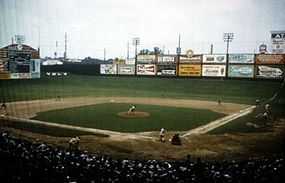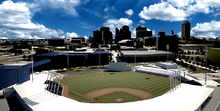Sulphur Dell
| Sulphur Dell | |
|---|---|
|
Athletic Park Suffer Hell | |
 Sulphur Dell, with the famous right field incline visible | |
| Location |
900 Fifth Avenue North Nashville, Tennessee |
| Coordinates | 36°10′23.31″N 86°47′7.39″W / 36.1731417°N 86.7853861°WCoordinates: 36°10′23.31″N 86°47′7.39″W / 36.1731417°N 86.7853861°W |
| Opened | 1870 (grandstand built 1885) |
| Renovated | 1927 |
| Closed | September 7, 1963 |
| Demolished | 1969 |
| Owner | Nashville Vols |
| Operator | Nashville Vols |
| Surface | grass |
| Capacity | 8,500 |
| Field dimensions |
Left Field: 334 ft (102 m) Center Field: 421 ft (128 m) Right Field: 262 ft (80 m) |
| Tenants | |
|
Nashville Americans (SOU) (1885–1886) Nashville Blues (SOU) (1887) Nashville Tigers (SOU) (1893–1894) Nashville Seraphs (SOU) (1895) Nashville Centennials (CL) (1897) Nashville Vols (SA) (1901–1961) Nashville Vols (SAL) (1963) | |
Sulphur Dell is a former minor league baseball park in Nashville, Tennessee. It was used for baseball for nearly 100 years, from 1870 to 1963. From 1901 to 1963, it was the home of the Nashville Vols minor league team. The ballpark, demolished in 1969, was located in the block bounded by present day Jackson Street, Fourth Avenue, Harrison Street, and Fifth Avenue.
In August 2013, the city of Nashville was announced to be in negotiations with the state of Tennessee, which currently owns the land, to locate the new Nashville minor league stadium in this location, to be home to the Nashville Sounds.[1] On November 8, 2013, a deal was announced to build the New Nashville Ballpark at Sulphur Dell, with construction slated to begin in 2014 and to be completed in time for the 2015 Pacific Coast League season.[2] The deal received final approval on December 10, 2013.[3] The new stadium will have 8,500 fixed seats, with an overall capacity of 10,000 people.
History
The park was located near an area known to pioneers as Sulphur Springs Bottom, a bottomland or dell which had a natural sulphur spring, and was located in the area of French Lick Springs. The lands were used for trading, picnics, and recreation. Baseball was first played there shortly after the end of the Civil War. Eventually, a portion of the land was designated for baseball and called Athletic Park. The park earned its better known nickname in 1908, when Grantland Rice, a local sports journalist for the Nashville Daily News and the Nashville Tennessean, referred to the ballpark as Sulphur Spring Dell—later shortened to Sulphur Dell.
The original grandstand was built in 1885. It was torn down in the winter of 1926 and 1927, and was rebuilt as a concrete-and-steel structure with a slightly different orientation.
Sulphur Dell was best known for having one of the most significant "terraces" or sloping outfields in baseball history: a steep incline that ran along the entire outfield wall, most dramatically in right and center fields. The right field fence was only 262 feet from home plate. Whenever games attracted very large crowds, fans sat on the shelf of the right field slope, cutting right field down to 235 feet from the plate. Most right fielders stood about halfway up the slope and were known as "mountain goats." The area was subject to flooding when the Cumberland River exceeded its banks.
The park was located adjacent to the Nashville stockyards and the meat packing district, which lent a unique fragrance to the surroundings. It was also known for being extremely friendly to hitters, which led pitchers to call it "Suffer Hell." Casey Stengel once joked that he could bunt a home run down the first base line, which was only 42 feet from the stands. The third base line was even closer, at 26 feet.
The Vols folded after the 1963 season. The park was converted to a speedway in 1964 but the speedway only operated for a year. In 1969, the decaying structure was demolished. It is the site of a number of parking lots north of the Tennessee State Capitol, and is bisected by a stretch of the Music City Bikeway cycle path.
Baseball returns to Sulphur Dell

On December 10, 2013, Metro and State of Tennessee officials approved plans for a new baseball stadium for the Triple-A Nashville Sounds of the Pacific Coast League. The stadium, known as the New Nashville Ballpark, will be built on the former site of Sulphur Dell and will replace Herschel Greer Stadium, the Sounds' current home.[4] The stadium will hold up to 10,000 people, with 8,500 of that in fixed seating and the rest in open areas, such as grass berms.[5] The cost of the entire development, including commercial and retail space, a greenway, and a parking garage, will be almost $150 million; the stadium itself will cost $37 million.[6][7] The new stadium should be completed by the beginning of the 2015 season.[6]
References
- General
- Nipper, Skip. Baseball in Nashville. Charleston, SC: Arcadia Publishing, 2007. ISBN 978-0-7385-4391-8
- Specific
- ↑ Rau, Nate; Garrison, Joey (21 Aug 2013). "$80 million new Sounds stadium project at Sulphur Dell in the works". The Tennessean. Retrieved 22 Aug 2013.
- ↑ Farmer, Blake (8 Nov 2013). "We Have A Deal: Governor, Mayor, Sounds Agree On New Baseball Stadium". WPLN News. Retrieved 8 Nov 2013.
- ↑ Cass, Michael (11 Dec 2013). "Metro Council approves Nashville Sounds ballpark deal". The Tennessean. Retrieved 11 Dec 2013.
- ↑ "Ballpark at Sulphur Dell". Metropolitan Government of Nashville and Davidson County, Tennessee. 12 Dec 2013. Retrieved 12 Dec 2013.
- ↑ Hale, Steven (25 Oct 2013). "City reveals details about Sulphur Dell stadium". NashvillePost.com. Retrieved 12 Dec 2013.
- ↑ 6.0 6.1 "Fact Sheet - Sulphur Dell Ballpark Proposal". Metropolitan Government of Nashville and Davidson County, Tennessee. 11 Nov 2013. Retrieved 12 Dec 2013.
- ↑ Hale, Steven (11 Dec 2013). "Council Signs Off on Sounds Stadium at Sulphur Dell". Nashville Scene. Retrieved 12 Dec 2013.
External links
- Skip Nipper's Sulphur Dell website
- Project Ballpark profile (includes pictures)
- The Tennessee Encyclopedia of History and Culture entry
| |||||||||||